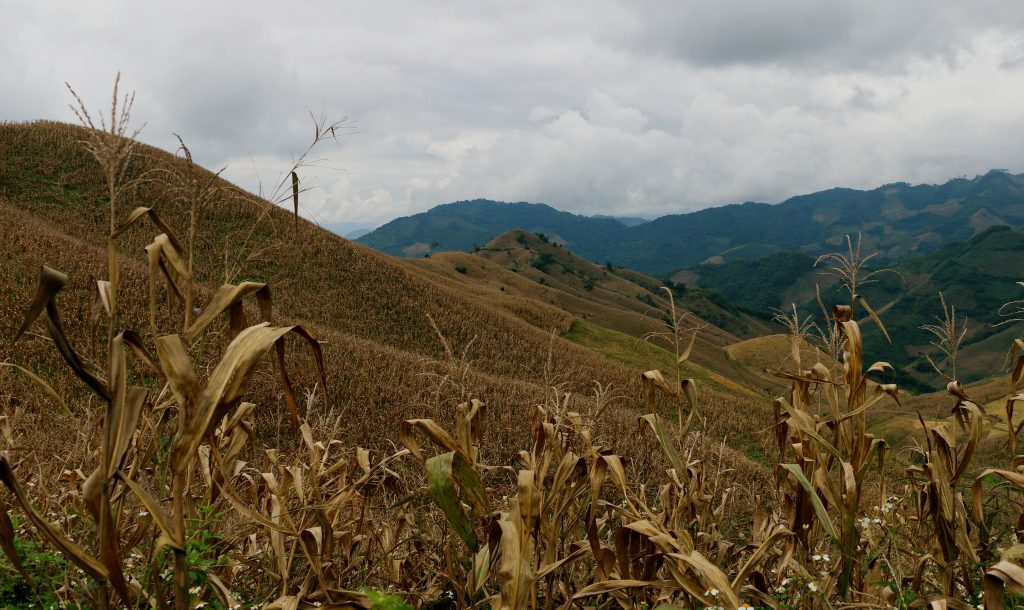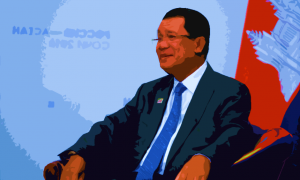Ordered lines of rubber that tower over a red, dirt road. Rolling hills of maize that locals have dubbed ‘bald mountains’ as far as the eye can see. Valleys and foothills blanketed with banana, cassava, and watermelon fields. These images characterise the changing rural landscapes of mainland Southeast Asia, where a mosaic of rice, upland gardens, bush fallows, and lush forests is succumbing to mono-cultured boom crops. As the world wrestles with the IPCC Climate change and land report’s grim assessment of how land conversions contribute to global climate change, we aim here to highlight the complex, problematic and significant phenomenon of cash crop booms.
Our session at the September 2019 European Association for Southeast Asian Studies (EuroSEAS) conference in Berlin tackled this crucial topic of crop booms, with a focus on mainland Southeast Asia. This post shares some key insights from that session, in order to alert scholars and practitioners to the urgency of this issue. Here, we identify three key areas for investigation and action, that refocus attention onto crop booms involving smallholders, in contrast with recent attention to large-scale corporate concessions.
Boom landscapes, boom mentalities
The transformative capacity of crop booms across Southeast Asia is alarming. Tree-based boom crops alone (e.g. rubber, oil palm, eucalyptus) are estimated to constitute 18% of the landscape in mainland Southeast Asia, a majority of which replaced forest land (Hurni & Fox 2018). The images presented above attest to the monumental landscape changes brought about by crop booms. What follows are extensive environmental problems including deforestation, land degradation, loss of biodiversity, as well as pollution and health risks from agri-chemicals and plastics. In northern Laos and Myanmar, for example, plastics used to protect young watermelon seedlings are burned after harvest, while plastic bags that insulate young banana branches in the winter months are later ploughed into the soil. In both cases, there is no attention to the long-term environmental consequences.
Boom crops also bring irrevocable economic and social changes. The cassava boom in Cambodia, for example, has brought new levels of cash income to some participating households, but contributes to the rising cost of land, food and other consumables. In boom regions, some households gain the capacity to build new houses, send children to school, or invest in agricultural and transport equipment, while others lose out and may enter vicious cycles of household debt and land loss. Thus, smallholder crop booms often exacerbate existing inequalities or create new economic differentiations.
In addition, crop booms can trigger profound cultural shifts. For many people and communities, the increasingly common transition from subsistence to market production or from working one’s own land to wage labour and landlessness brings with it new aspirations and an altered worldview. For example, among indigenous Bunong in upland Cambodia, aspirations for personal income and control of land have created tensions regarding collective customary land ownership. Thus, boom crops sit within a changing landscape of agrarian capitalism that can challenge and transform customary values and social relations.
Centering smallholders within multi-scale networks
Centering attention on smallholders in large-scale landscape transformations has strategic implications for reshaping responses to crop booms. In contrast to large-scale land grabbing, where corporations acquire thousands of hectares of land through a single purchase or lease agreement, smallholder crop booms involve a much wider and complex setup of small transactions and investments. Smallholder crop booms are driven by dynamic and diverse constellations of actors including local entrepreneurs, domestic investors, cross-border traders, state actors at different levels, and transnational corporations of different shapes and sizes, that operate locally, sub-nationally, across borders, nationally and globally (see for example Friis & Nielsen, 2016, 2017; Cole et al. 2019; Lu 2017; Lu & Schönweger 2019; Mahanty 2018). While this complex mix of actors is often needed to facilitate and fuel crop booms, smallholders play pivotal roles in mediating access to land, labour, and resources. Thus, smallholder farmers represent a key lynchpin between global market pressures and corporations, and localised rushes to access fertile land and other supporting resources. Agri-food conglomerates often rely on arms’ length systems of contract farming arrangements that enable them to capture the value of production, while running the risks and costs of coordination through networks of traders, and avoiding social and environmental externalities. For example, maize cultivation, which has exploded along the Lao-Vietnamese border, is primarily done on smallholder land through contract farming but is highly coordinated downstream where the maize is sold to CP, Asia’s largest feed and agri-food corporation (see for example Cole & Rigg 2019).
This makes crop booms difficult to identify, monitor and target for interventions. Moreover, states and development aid organisations often approach booms with optimism, viewing them as potential engines for locally driven development and economic growth. When ‘booms go bust’ due to ecological collapse or market failure, those involved often look for the next crop boom opportunity instead of engaging in long-term planning of more sustainable modes of agricultural production. This level of complexity and the lack of visible, responsible actors makes it difficult to research as well as address the socio-environmental impacts of crop booms.

Banana worker in Oudomxay Province, Laos (Photo: Isabelle Vagneron)
Market volatility and governance challenges
A third inherently challenging aspect of crop booms is that they operate within constantly changing and highly contingent conditions. Their diverse and specific materialities further limit silver bullet solutions to their problematic impacts.
Boom crops are volatile in multiple ways. Rapid ‘busts’ commonly follow a crop boom when local and international market prices, trade policies or other market regulations shift, or when ecological conditions deteriorate to the extent that cultivation of a given crop is no longer feasible or even possible. Cassava and banana production, for example, are currently wracked with the rapid spread of disease (Cassava Mosaic Disease, and Panama disease or Fusarium Wilt Tropical Race 4 respectively).
In mainland Southeast Asia, crop booms are particularly pronounced in the borderlands between the countries where cash crops are largely grown (Laos, Cambodia, and Myanmar) and their neighbours where they are usually processed, consumed, or exported onward (Thailand, Vietnam and China). These borderlands are typically distant from political and infrastructural centres, and are commonly sites of relatively recent military and/or ethnic conflict. These frontier and post-conflict characteristics often combine more flexible or newly established land regimes with lower intensities in land and resource use. Finally, borderland communities tend to have strong cross-border sociocultural and linguistic ties which can facilitate rapid flows of capital, information, expertise, and input from more developed agricultural markets over the border. This, in turn, can contribute to the rapid rise of new economic relationships and channels of cross-border trade and exchange.

Trader buys dried cassava from an upland farmer in Mondulkiri Province, Cambodia (Photo: Sango Mahanty)
The cross-border dynamics of mainland Southeast Asia’s crop booms mean that governments may face jurisdictional and geopolitical challenges in regulating boom crops, in settings where state-presence is already fragmented. The end result is that, in spite of their highly consequential effects, crop booms are typically ungoverned or governed through reactive, ad hoc political responses which often prove ineffective or impossible to implement. Where problems emerge, such as inappropriate pesticide use for bananas or soil degradation with cassava, policy responses tend to be reactive, are highly crop-specific, and attempt to change the behaviour of individual actors, such as farmers, rather than addressing more systemic dimensions of the boom.
The social-material characteristics of boom crops also raise governance challenges. Each crop involves different social relations of production, such as labour and land arrangements, the level and type of processing involved, infrastructure needs and trading networks. The cultivation requirements and production cycle of a crop determines the spatial and temporal aspects of its expansion into a landscape. For example, cassava and maize are short-term crops that can initially be grown with minimal inputs, which lowers the barriers to entry for smallholders. Bananas and rubber, on the other hand, are perennial crops that require relatively large up-front investments, which means they are often established through altogether different types of land and production arrangements.
Introducing ‘Rupture: nature–society transformation in mainland Southeast Asia’
Studying structural reconfigurations of nature and society in the Mekong region and beyond.
Conclusions
The uniqueness and the global significance of smallholder crop booms demands more attention, especially as they play out in borderlands of mainland Southeast Asia. Each crop boom unfolds differently, with unique combinations of stakeholders, over different time spans, through diverse mechanisms and with disparate outcomes. Yet these booms all have profound impacts. As such, we need to better understand, through transdisciplinary approaches, the diverse range of actors, processes and interactions involved in driving smallholder crop booms. How do those affected by such booms negotiate their way in and out of them, either alone or collectively? In terms of governance, the complexity of the settings and dynamics of crop booms cautions against a one-size-fits all approach. Instead, a nuanced approach is needed that considers the different levels of agency of the diverse stakeholders involved. Recentering attention on smallholder crop booms is vital, as our research demonstrates that although their effects may be less visible than large-scale land grabs, they can be equally transformative for frontier landscapes and livelihoods.
 Facebook
Facebook  Twitter
Twitter  Soundcloud
Soundcloud  Youtube
Youtube  Rss
Rss 






